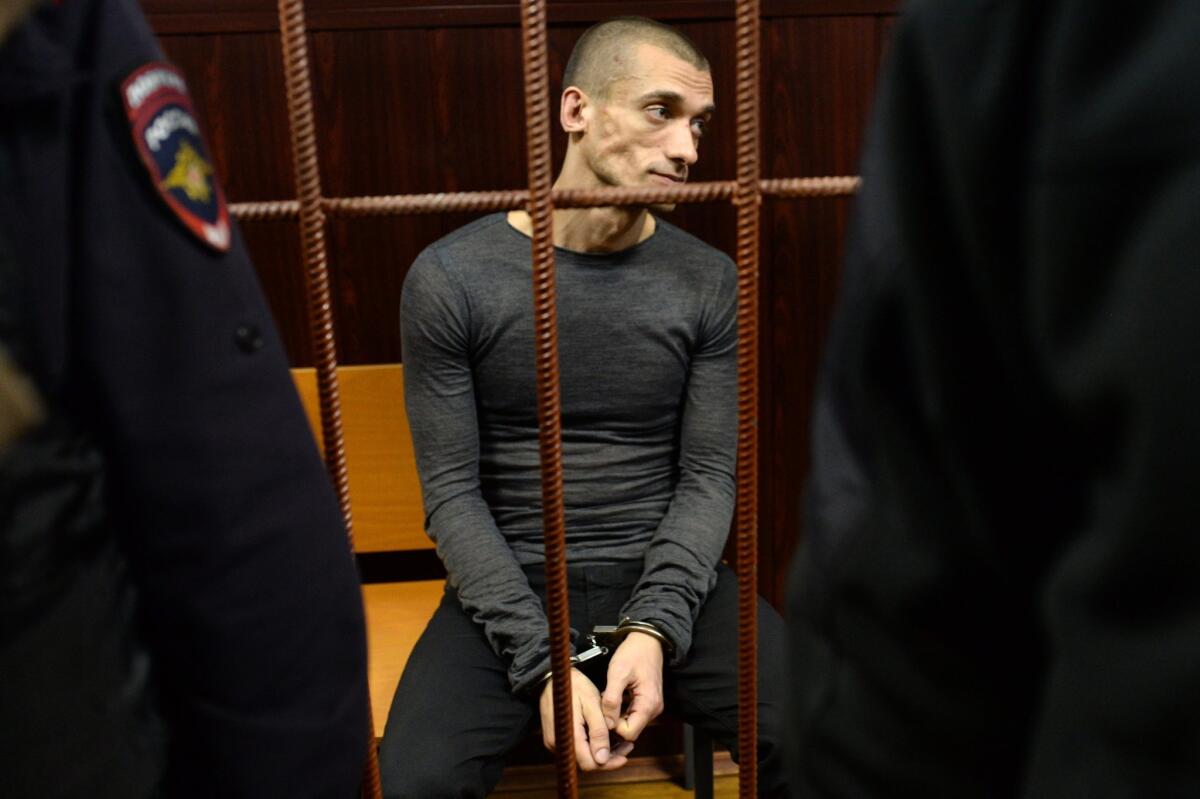Kremlin strikes back: Russian dissident artist ordered to psychiatric clinic

Russian performance artist Pyotr Pavlensky sits in a courtroom before a hearing on his case in Moscow on Nov. 10, 2015.
- Share via
Reporting from Moscow — Pyotr Pavlensky does not spare his body or his audience when it comes to his macabre artistic “actions.”
The gaunt, 31-year-old artist nailed his scrotum to the pavement of Moscow’s iconic Red Square to protest ubiquitous police brutality in Russia. He had his naked body wrapped in barbed wire in front of a government building as a metaphor for persecution of Kremlin critics.
He sewed his mouth shut to support the arrested Pussy Riot feminist rockers and cut his earlobe off with a knife while sitting on a wall outside the Serbsky psychiatric clinic in Moscow to protest the forced psychiatric treatment of dissenters.
Last week, he was forcibly transferred to Serbsky for a three-week “evaluation” after refusing to undergo a voluntary psychiatric examination, according to his partner, Oksana Shalygina.
Pavlensky is the first Russian artist forcibly sent to a psychiatric clinic since the 1991 Soviet collapse, according to Maria Alyokhina of Pussy Riot, who now heads a human rights group that helps inmates in Russia’s notorious penitentiary system.
“They could hold him there indefinitely,” she said.
Shalygina said his evaluation was motivated by his latest performance, in November, in which he set fire to the doors of the Federal Security Service, or FSB, the domestic successor agency to the Soviet KGB.
Pavlensky doused the doors with gasoline, lighted them and posed for a photograph. He was immediately arrested.
The burning doors were intended to symbolize the gates of hell in President Vladimir Putin’s Russia, Shalygina said. Putin is a former KGB agent who served for a time as head of the FSB.
For Russian investigators, Pavlensky’s evaluation and a possible forced treatment “would be a very desirable and painless way to send him away,” she said. She added that Pavlensky is being held incommunicado because of a flu quarantine and has no contact with her or his lawyer.
The Serbsky clinic was the Soviet Union’s most notorious center of “punitive psychiatry,” which allowed the communist government to silence thousands of dissidents — and scare many more potential critics.
Dissidents were committed to the clinic to be diagnosed and then sent to provincial or prison hospitals where many suffered irreparable damage to their mental and physical health. Among them was poet and human rights advocate Natalia Gorbanevskaya, whose ordeal was described by Joan Baez in a 1976 song, “Natalia.”
The clinic’s psychiatrists, some of whom often doubled as high-ranking security officers, diagnosed the dissenters with vaguely defined “sluggish schizophrenia” that allowed indefinite confinement, often in isolated cells with no beds.
Pavlensky was briefly evaluated in the Serbsky clinic in 2014 and pronounced sane — which makes the current, longer evaluation more ominous, Shalygina said.
The artist said the performance that landed him in the mental institution was meant to symbolize the threat of a communist-era “Red Terror” being resurrected by Putin’s security forces.
“The dark events and institutions from the past live on in today’s ‘security services.’ They have insinuated their way into the fabric of Russian society,” he wrote in an op-ed published by the English-language Moscow Times in December.
Pavlensky has been charged with vandalism motivated by “ideological hatred” and faces up to three years in jail, officials said.
His attorney says he committed no crime. “They consider what he did a punishable crime,” Svetlana Ratnikova said. “We think it’s a creative performance.”
One prominent Kremlin critic said that Pavlensky’s case is a new step in the persecution of dissidents under Putin.
“Since the authorities decided that there would be no dialogue with political opponents, they will use other methods of retaining power, such as criminal cases, persecution, forced emigration, smear campaigns in the media, and then, of course, they will start declaring people mad,” opposition leader and former lawmaker Gennady Gudkov said.
There have been other recent cases of dissidents forcibly sent to mental institutions.
Alyokhina and her Pussy Riot bandmate Nadezhda Tolokonnikova underwent a four-hour psychiatric evaluation during the internationally condemned trial that followed the band’s 2012 “punk prayer” at Russia’s largest Orthodox cathedral. They were sentenced to two years in jail.
They consider what he did a punishable crime. We think it’s a creative performance.
— Svetlana Ratnikova, attorney for Pyotr Pavlensky
Pavlensky has said he considers the official responses to his art, including his detention and negative coverage in the Kremlin-controlled media, to be part of the performance.
Authorities “start to build the event. They turn into characters. Everything is built around them. My action is minimal. I just sit, do nothing or stand,” Pavlensky told writer Anastasiya Belyaeva, who published a book about him last year.
The Russia-24 television network called Pavlensky “socially dangerous.”
But some art critics have praised his work, saying it is an apt reflection of the time.
“A picture of Pavlensky standing in front of burning doors refers us to the image of the gates of hell, emphasizing where the root of evil in Russia is,” renowned art critic Marat Guelman wrote in an op-ed published by the Slon newspaper in November.
“This is not elite art that is located in galleries and addresses connoisseurs and collectors,” Guelman wrote. “This is a very popular product, pre-calculated and aimed at mass media, the state machine and the public in general.”
Pavlensky’s “actions” have been influenced by decades of Soviet and Russian performance art and political activism.
Soviet youngsters burned rag dolls of top-hat-wearing Western capitalists, pro-Putin youth movements dumped the books of anti-Kremlin writers in a giant “toilet seat” installed at a Moscow square or tried to catch an opposition leader in a huge butterfly net because he was a “political insect.”
Since the early 1990s, several performance artists have publicly destroyed Christian icons to protest the conservative policies of the country’s dominant Orthodox Church. They also have used laser tags to project skull-and-bones images on government buildings, and staged rallies with absurd slogans such as “lentils are evil” or “a good president is a bad dancer.”
Pavlensky is not the only unorthodox artist to be persecuted in Russia in recent years.
Several criminal investigations have been opened against artist Artyom Loskutov, who is accused of inciting religious hatred with his “icons” on T-shirts and billboards that portrayed Pussy Riot members as the Virgin Mary or as Orthodox saints.
Activists with War, a radical artists group that once included the members of Pussy Riot, have been arrested and beaten. They eventually fled to Italy to avoid persecution.
In 2010, two art curators in Moscow were convicted and fined for organizing an art exhibition that included images of Jesus Christ depicted as Mickey Mouse and Soviet founder Vladimir Lenin. The exhibition was closed after Orthodox activists stormed in, damaging some exhibits.
Performance artist Oleg Mavromatti had himself publicly nailed to a wooden cross in Moscow in 2000 with the words “I am not a son of God” carved on his skin with a razor. He was charged with inciting religious hatred and left Russia for the United States.
Some aspects of this art date to medieval Russian traditions of “holy fools,” or eccentric Orthodox monks or ascetic laymen who would often mortify their flesh and criticize officials or even czars with impunity.
One of the so-called holy fools was St. Basil, or Basil the Blessed, who walked naked even during Russian winters, dared lambaste czar Ivan the Terrible and was buried just yards from where Pavlensky nailed his scrotum to the pavement of Red Square.
Unlike Pavlensky, he was never punished – and the magnificent, multicolored St. Basil’s Cathedral, one of Russia’s postcard symbols, was erected over his grave in honor of him.
Mirovalev is a special correspondent.
More to Read
Sign up for Essential California
The most important California stories and recommendations in your inbox every morning.
You may occasionally receive promotional content from the Los Angeles Times.










